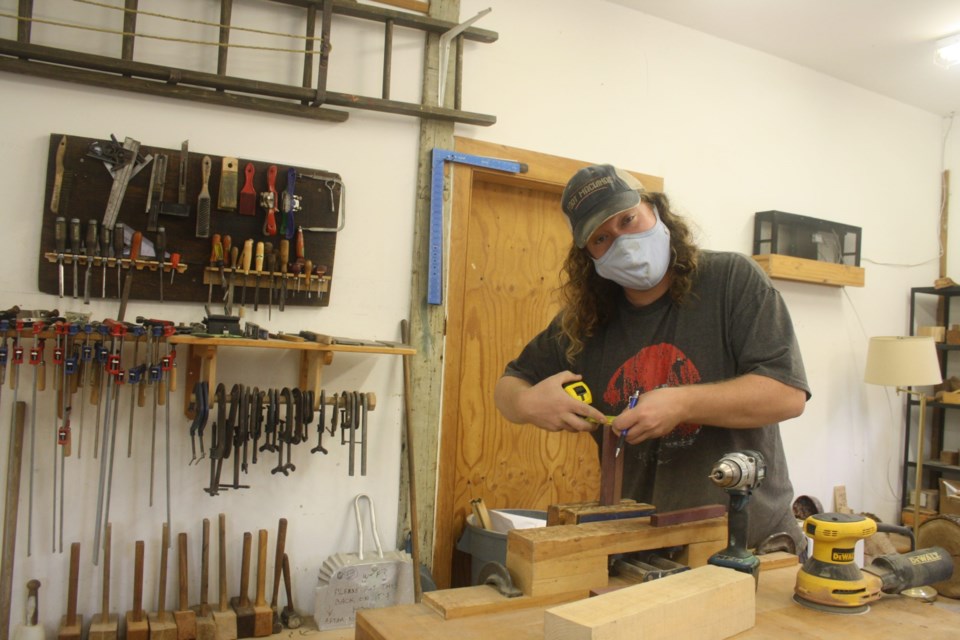Despite the rather gloomy day, the light of Willowbank Estate as a unique school of restoration arts shone brightly Saturday, during the first Explore Queenston event, which opened the doors to some of its historic buildings and exhibits to showcase all the village has to offer.
Caitlin Wooll, director of the school of restoration arts at Willowbank, has worked at the estate for about five years, and has organized several well-attended public events at the school in that time. She was pleased to see the number of people who dropped in to explore Willowbank Saturday, and grateful for the opportunity to showcase the school, when so many annual events have had to be cancelled.
She senses there is great interest for the historic building sitting atop the hill in the community, including among those who have seen it, but not been inside.
She sensed people were enjoying being able to be out and about, and able to take advantage of the opportunity to learn what goes on inside the historic building, she says, some surprised by what they saw.
In addition to learning about the school of restoration arts, which offers a three-year, hands-on program unique in Canada focusing on skills related to conserving built and cultural heritage, visitors are fascinated by the building itself.
While the upper floor rooms are still being converted for additional classroom space, the main floor might also appear to be undergoing renovations to visitors seeing it for the first time.
As Wooll explains, she welcomes those conversations as an opportunity to explain the plans for Willowbank.
“It’s been really nice to see people coming through, after so long. They tell us ‘we love what you do, love to see what’s inside,’” she says. “And we like to be able to talk about what we’re doing here. People ask about the wallpaper, the paint, and when we’re going to finish this room. It gives us a chance to explain we’re not going to restore it as a time capsule. People are surprised but also pleased to hear that we’re leaving it the way it is.”
As for classes, they have been ongoing throughout the pandemic, says Wooll.
Because they have always been small, typically eight students and an instructor, they could continue throughout the lockdown without interruption, with enough space for distancing.
“Fortunately our students haven’t lost any time,” she says, and loved being onsite for events such as Saturday, to talk about what they do.
“For some this is their first open house, and they’re happy to experience it.”
Chris Thorne was one of the students demonstrating the skills he’s learned and explaining it to the public.
In his third year at the school for restoration arts, Thorne, while doing some woodworking in the barn on the estate Saturday, tells The Local that although he is still a student, he has already started his own business.
His specialty is repairing and restoring windows and window sashes in old buildings across the Niagara Region.
“It keeps me busy,” he says, adding that the biggest problem is the difficulty in getting the materials he needs.
He grew up in a historic house in Mississauga, built in the 1830s, which his grandfather bought in the 1970s. It is one of the oldest in the area, he says, and he learned some of his restoration skills from his grandfather and father. It was certainly part of what has fostered his love of historic restorations.
He is also a licensed archeologist, and has worked with ASI, a Toronto firm that has done work in NOTL, on stage 3 and 4 assessments of historic sites.
While at Willowbank, he has worked on window restoration and maintenance projects.
Hie spends some of his time searching out tools in antique shops, but mostly he is out looking for old books. And clocks — he is also into repairing them, a skill that is self-taught, learned while tinkering with them over the years.
Thorne does his carpentry work in the barn, a structure as integral to Willowbank as the learning that takes place inside.
It was originally on the property of the Phillips Estate, owned by Rainer Hummel, at the corner of Queen and Mississagua Street. In the early days for the school of restoration arts, students and staff dismantled and documented the barn, and a chicken coop beside it, and they were moved to the current site at Willowbank.
The barn bears the name of Bram and Bluma Appel, a Toronto couple who had a home in NOTL, and who were known for their support of arts and culture. The barn was donated and moved to the site by the Appel family and adapted into two workshop spaces for carpentry and masonry projects, an example of an adaptive reuse project for the students involved in its relocation.
As Thorne works on a carpentry project in the barn, using a combination of old tools and new, which can get the job done faster, he loves what he is learning at Willowbank, and not just about woodworking. What Willowbank offers is much more, he says, including “the kinds of things we explore and discuss here that haven’t reached the academic field yet.”
On the front porch of Willowbank, Amanda Hansen, director of sales for 124 on Queen Hotel & Spa, explains the venue partnership with Willowbank, 124 on Queen and Treadwell Cuisine, providing catering for events held on the historic estate.The National Historic Site can offer catered, tented events such as weddings, on the grounds of the estate, or inside for smaller gatherings in the Bright Parlour.
